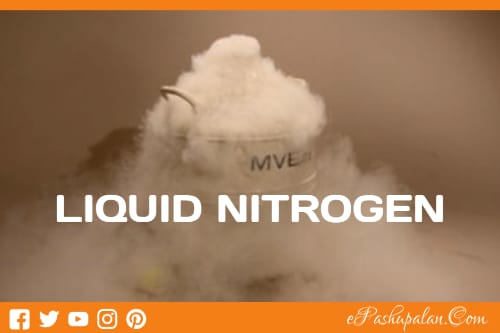Nitrogen is an inorganic material which is sold in largest quantity (in terms of volume) in the world. Nitrogen is mostly used as a cryogenic liquid in scientific and technical institutes. Semen of domestic animals is one of the biological materials which is kept stored in liquid nitrogen gas for very long periods. A specially designed cylinder is employed for this purpose. In addition to this, spare nitrogen gas is kept in storage tanks which may be pressurized or non-pressurized. The cylinder which stocks semen straws is mostly non-pressurized. Whenever need arises, the semen straws are extracted out of these cylinders and are used after following appropriate procedures.

Liquid Nitrogen Cylinder
It is very much similar to a thermos. It consists of a two layered jacket. The outer layer is made up of a strong metal. In most cases, aluminium is used. It is the best choice because of its light weight. It is, often, painted with polyurethane so as to avoid environmental insults. It is known to prolong its life. Vacuum is created inside the two layered jacket. This jacket is also filled with a high quality heat insulator. Both heat insulator and vacuum prevent evaporation of liquid nitrogen to a great extent. Because of presence of liquid nitrogen, the inside of cylinder has a temperature of ‐320 °F. Because of vacuum, this temperature can be maintained till the level of liquid nitrogen is still 2-3 inches inside the cylinder. When liquid nitrogen contents fall below this level, the temperature inside cylinder rises sharply which will have deleterious effect on semen present inside that particular cylinder.
The structure of liquid nitrogen cylinder get improved to such an extent that the gas can be stored effectively for 6-9 months. In spite of these technological advances, the inner jacket of the cylinder can get damaged permanently if the cylinder is not handled with utmost care. Cracks can develop in this layer. Liquid nitrogen cannot be stored for very long in such cylinders. Therefore, following measures should be followed to prolong the effective life of a liquid nitrogen cylinder.
- The cylinder should be kept in a clean and dry place. It should never be placed directly over the floor especially the damp one. It is better to position it over a wooden plank.
- It should be laid in a cool and dark room away from sunlight. The room should be well ventilated but the air flow should be restricted. When the room is closed from all sides and the cylinder remains opened for a prolonged period or it is uncapped repeatedly, the nitrogen level in the air will rise. It may lead to breathing problems.
- It should always be kept beyond the reach of children. At the same time, it must remain under the watchful eyes of the expert personnel. They must be able to check the liquid nitrogen level inside the cylinder frequently.
- If the outer side of cylinder gets damp or soiled with dung, caustic material or anything that can damage the outer layer, then, it should be removed immediately. It can also be washed with clean water.
- The cylinder should be kept in upright position whenever it is shifted from one place to another. It is always better to get help from another person in doing so. Always try to avoid sudden jerks.
- It is better not to bring the liquid nitrogen cylinder inside a lift (elevator).
- The inner jacket of the cylinder is attached to the outer layer at neck tube. This neck tube can easily get damaged when the cylinder experiences a jerky movement or swinging movement or when it is thrown from a height. This may result in losing the vacuum inside the cylinder. With this, the capacity of the cylinder to keep nitrogen in liquid state for longer periods also goes off.
- When the cap of the cylinder is removed, it should be ensured to replace it back to its original position as soon as possible. In case the cylinder remains open without cap for a prolonged period, the whole lot of gas can get evaporated. This will result in spoilage of full consignment of semen straws.
- The caps of different cylinders should be identifiable. They should not get interchanged.
- The speed with which liquid nitrogen evaporates depends upon the life and current state of the cylinder. It also depends upon the way the cylinder is handled. The gas evaporates faster when the cylinder is opened repeatedly at short intervals. During journeys, the liquid nitrogen is stirred continuously leading to its faster loss. It, therefore, becomes mandatory to check the liquid nitrogen level in the cylinder every week.
- The cap or neck tube of the cylinder should not harbour excessive quantity of ice flakes. If, an undue amount of ice crystals get deposited inside neck region, it indicates loss of vacuum system of that particular cylinder. The damaged cylinder can’t store liquid nitrogen for a substantially long period. Under such circumstances, the level of liquid nitrogen in the cylinder should be got checked with the help of a flattened wooden rod. If there is still a good quantity of gas available in the cylinder, the whole lot of semen straws should be transferred immediately to another gas-filled normal cylinder. If the level of liquid nitrogen is too low, the semen straws should be got checked for quality before further use.
- When the level of liquid nitrogen is to be checked in the cylinder, a wooden rod (measure) should always be used. The plastic measure, when dipped in liquid nitrogen, becomes brittle and breaks easily.
Precautions to be Taken While Using LN2 Gas
Presence of nitrogen in the atmosphere cannot be sensed by human nose. Therefore, one has to pay special attention while working with liquid nitrogen gas. A few precautions have been listed hereunder for avoiding disasters.
- Liquid nitrogen gas is colourless, odourless and nonflammable. It is extremely cold. Under normal atmospheric pressure, it starts boiling at -196 ° When boiling starts, it gets converted into lots of gaseous vapours. Whenever a liquid nitrogen container is uncapped, white coloured clouds appear above the mouth of the container. These clouds are not formed of nitrogen gas, rather, water vapours present in the nearby area get condensed to form clouds.
- Liquid nitrogen should only be stored in special containers.
- When liquid nitrogen is to be transferred from primary cylinder (storage tank) to one intended for storing semen straws, it should be ensured that the cylinder contains some amount of liquid nitrogen in it. If it is completely empty, or when the transfer is to be made for the first time, its temperature may be too high. Spillage may occur at the time of transfer because liquid nitrogen expands quickly at relatively higher temperatures. It is better to pre-cool the container for some time before filling it.
- It is always better to use Personal Protective Gear (safety glasses, latex gloves, protective face shield and protective vests) while working with liquid nitrogen. It should never be taken lightly even if working for a few moments or working with a very small quantity of liquid nitrogen.
- Semen straws extracted from liquid nitrogen can explode suddenly when thawed at warmer temperatures. So, proper procedures should be followed to protect eyes.
- The unused liquid nitrogen should neither be disposed off in dustbins nor in sink drains. These structures cannot sustain cryogenic temperatures. They can get cracked easily.
- Liquid nitrogen should be transferred very slowly. This will lower any kind of stress arising because of expansion and contraction of the inner layer of the cylinder.
- Never use a funnel while transferring liquid nitrogen.
- It is a good practice to remove watch, rings or any other similar objects before going for transfer operation.
- Any object dipped in liquid nitrogen should never be touched directly with bare hands. It may cause frost bite. Liquid nitrogen is too cold. It may cause freezing of skin tissues. When the object is pulled away, the skin also gets peeled off.
- Nitrogen gas is not poisonous in itself. However, its higher concentration in a closed room may cause relative reduction in oxygen level. Breathing can become problematic when oxygen level falls below 19.5 per cent.
First Aid during LN2 Emergencies
- Inhalation of nitrogen can cause nausea, vomiting and unconsciousness. A person becoming unconscious should be immediately taken to a well ventilated area. In case of difficulty in breathing, oxygen can be given. The affected person should be kept warm till the doctor arrives.
- During spillage over the skin, pour ample warm water to bring the area to normal temperature. Clothes and other articles should be immediately taken off. The affected area can also be kept dipped in warm water (42 °C). It should never be massaged.
- In case of accidental contact with eyes, these should be flushed with plenty of clean and warm water.
The above listed precautions, if followed in letter and spirit, can prevent major accidents arising out of use of liquid nitrogen.







Be the first to comment